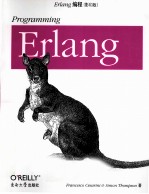图书介绍
Erlang编程 英文版PDF|Epub|txt|kindle电子书版本网盘下载

- (瑞典)塞萨芮利,(英)汤普森著 著
- 出版社: 南京:东南大学出版社
- ISBN:9787564122690
- 出版时间:2010
- 标注页数:474页
- 文件大小:44MB
- 文件页数:495页
- 主题词:程序语言-程序设计-英文
PDF下载
下载说明
Erlang编程 英文版PDF格式电子书版下载
下载的文件为RAR压缩包。需要使用解压软件进行解压得到PDF格式图书。建议使用BT下载工具Free Download Manager进行下载,简称FDM(免费,没有广告,支持多平台)。本站资源全部打包为BT种子。所以需要使用专业的BT下载软件进行下载。如BitComet qBittorrent uTorrent等BT下载工具。迅雷目前由于本站不是热门资源。不推荐使用!后期资源热门了。安装了迅雷也可以迅雷进行下载!
(文件页数 要大于 标注页数,上中下等多册电子书除外)
注意:本站所有压缩包均有解压码: 点击下载压缩包解压工具
图书目录
1.Introduction1
Why Should I Use Erlang?1
The History of Erlang3
Erlang's Characteristics4
High-Level Constructs4
Concurrent Processes and Message Passing5
Scalable,Safe,and Efficient Concurrency6
Soft Real-Time Properties6
Robustness6
Distributed Computation7
Integration and Openness8
Erlang and Multicore9
Case Studies10
The AXD301 ATM Switch10
CouchDB11
Comparing Erlang to C++12
How Should I Use Erlang?14
2.Basic Erlang15
Integers15
The Erlang Shell16
Floats17
Mathematical Operators17
Atoms19
Booleans20
Tuples21
Lists22
Characters and Strings22
Atoms and Strings23
Building and Processing Lists24
List Functions and Operations25
Term Comparison28
Variables30
Complex Data Structures32
Pattern Matching33
Functions38
Modules40
Compilation and the Erlang Virtual Machine40
Module Directives41
Exercises43
3.Sequential Erlang45
Conditional Evaluations46
The case Construct46
Variable Scope48
The if Construct49
Guards50
Built-in Functions53
Object Access and Examination53
Type Conversion54
Process Dictionary55
Meta Programming55
Process,Port,Distribution,and System Information56
Input and Output57
Recursion59
Tail-Recursive Functions63
Tail-Call Recursion Optimization66
Iterations Versus Recursive Functions67
Runtime Errors68
Handling Errors70
Using try... catch70
Using catch74
Library Modules77
Documentation77
Useful Modules79
The Debugger80
Exercises82
4.Concurrent Programming89
Creating Processes90
Message Passing92
Receiving Messages94
Selective and Nonselective Receives97
An Echo Example100
Registered Processes102
Timeouts104
Benchmarking106
Process Skeletons107
Tail Recursion and Memory Leaks108
A Case Study on Concurrency-Oriented Programming110
Race Conditions,Deadlocks,and Process Starvation112
The Process Manager114
Exercises115
5.Process Design Patterns117
Client/Server Models118
A Client/Server Example119
A Process Pattern Example125
Finite State Machines126
An FSM Example127
A Mutex Semaphore129
Event Managers and Handlers131
A Generic Event Manager Example132
Event Handlers135
Exercises137
6.Process Error Handling139
Process Links and Exit Signals139
Trapping Exits142
The monitor BIFs144
The exit BIFs145
BIFs and Terminology146
Propagation Semantics148
Robust Systems148
Monitoring Clients150
A Supervisor Example152
Exercises154
7.Recordsand Macros157
Records158
Introducing Records158
Working with Records159
Functions and Pattern Matching over Records160
Records in the Shell161
Record Implementation162
Record BIFs164
Macros165
Simple Macros165
Parameterized Macros166
Debugging and Macros166
Include Files168
Exercises168
8.Software Upgrade173
Upgrading Modules173
Behind the Scenes176
Loading Code179
The Code Server180
Purging Modules182
Upgrading Processes182
The .erlang File186
Exercise186
9.More Data Types and High-Level Constructs189
Functional Programming for Real189
Funs and Higher-Order Functions190
Functions As Arguments190
Writing Down Functions:fun Expressions192
Functions As Results193
Using Already Defined Functions194
Functions and Variables195
Predefined,Higher-Order Functions195
Lazy Evaluation and Lists197
List Comprehensions198
A First Example198
General List Comprehensions198
Multiple Generators200
Standard Functions200
Binaries and Serialization201
Binaries202
The Bit Syntax203
Pattern-Matching Bits205
Bitstring Comprehensions206
Bit Syntax Example:Decoding TCP Segments206
Bitwise Operators208
Serialization208
References210
Exercises211
10.ETSand DetsTables213
ETS Tables213
Implementations and Trade-offs214
Creating Tables216
Handling Table Elements217
Example:Building an Index,Act Ⅰ218
Traversing Tables220
Example:Building an Index,Act Ⅱ222
Extracting Table Information:match223
Extracting Table Information:select225
Other Operations on Tables226
Records and ETS Tables226
Visualizing Tables228
Dets Tables229
A Mobile Subscriber Database Example231
The Database Backend Operations232
The Database Server237
Exercises242
11.Distributed Programming in Erlang245
Distributed Systems in Erlang245
Distributed Computing in Erlang:The Basics247
Node Names and Visibility249
Communication and Security250
Communication and Messages252
Node Connections253
Remote Procedure Calls256
The rpc Module258
Essential Distributed Programming Modules258
The epmd Process260
Distributed Erlang Behind Firewalls261
Exercises261
12.OTP Behaviors263
Introduction to OTP Behaviors263
Generic Servers266
Starting Your Server266
Passing Messages268
Stopping the Server270
The Example in Full271
Running gen_server273
Supervisors276
Supervisor Specifications277
Child Specifications278
Supervisor Example279
Dynamic Children280
Applications281
Directory Structure282
The Application Resource File283
Starting and Stopping Applications284
The Application Monitor287
Release Handling287
Other Behaviors and Further Reading290
Exercises291
13.Introducing Mnesia293
When to Use Mnesia293
Configuring Mnesia295
Setting Up the Schema295
Starting Mnesia296
Mnesia Tables296
Transactions299
Writing299
Reading and Deleting300
Indexing301
Dirty Operations302
Partitioned Networks304
Further Reading305
Exercises306
14.GUI Programming with wxErlang309
wxWidgets309
wxErlang:An Erlang Binding for wxWidgets310
Objects and Types311
Event Handling,Object Identifiers,and Event Types312
Putting It All Together313
A First Example:MicroBlog314
The MiniBlog Example317
Obtaining and Running wxErlang321
Exercises321
15.Socket Programming323
User Datagram Protocol323
Transmission Control Protocol327
A TCP Example328
The inet Module331
Further Reading333
Exercises334
16.Interfacing Erlang with Other Programming Languages335
An Overview of Interworking336
Interworking with Java337
Nodes and Mailboxes337
Representing Erlang Types338
Communication338
Putting It Together:RPC Revisited339
Interaction340
The Small Print341
Taking It Further342
C Nodes342
Going Further345
Erlang from the Unix Shell:erl_call346
Port Programs346
Erlang Port Commands347
Communicating Data to and from a Port349
Library Support for Communication350
Working in Ruby:erlectricity351
Linked-in Drivers and the FFI352
Exercises353
17.Trace BIFs,the dbg Tracer,and Match Specifications355
Introduction355
The Trace BIFs357
Process Trace Flags358
Inheritance Flags360
Garbage Collection and Timestamps361
Tracing Calls with the trace_pattern BIF362
The dbg Tracer365
Getting Started with dbg366
Tracing and Profiling Functions369
Tracing Local and Global Function Calls369
Distributed Environments371
Redirecting the Output371
Match Specifications:The fun Syntax374
Generating Specifications Using fun2ms375
Difference Between ets and dbg Match Specifications382
Match Specifications:The Nuts and Bolts383
The Head383
Conditions384
The Specification Body387
Saving Match Specifications390
Further Reading391
Exercises392
18.Types and Documentation395
Types in Erlang395
An Example:Records with Typed Fields395
Erlang Type Notation396
TypEr:Success Types and Type Inference399
Dialyzer:A DIscrepancy AnaLYZer for ERlang Programs401
Documentation with EDoc402
Documenting usr_db.erl403
Running EDoc405
Types in EDoc407
Going Further with EDoc408
Exercises410
19.EUnit and Test-Driven Development411
Test-Driven Development411
EUnit412
How to Use EUnit413
Functional Testing,an Example:Tree Serialization413
The EUnit Infrastructure416
Assert Macros416
Test-Generating Functions416
EUnit Test Representation417
Testing State-Based Systems418
Fixtures:Setup and Cleanup418
Testing Concurrent Programs in Erlang419
Exercises420
20.Style and Efficiency421
Applications and Modules421
Libraries422
Dirty Code423
Interfaces423
Return Values424
Internal Data Structures425
Processes and Concurrency426
Stylistic Conventions430
Coding Strategies435
Efficiency437
Sequential Programming437
Lists439
Tail Recursion and Non-tail Recursion440
Concurrency440
And Finally...442
Appendix:Using Erlang445
Index451